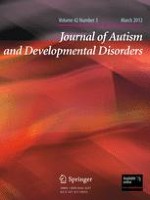01-03-2012 | Original Paper
Young Children with Autism Spectrum Disorder Do Not Preferentially Attend to Biological Motion
Gepubliceerd in: Journal of Autism and Developmental Disorders | Uitgave 3/2012
Log in om toegang te krijgenAbstract
Preferential attention to biological motion can be seen in typically developing infants in the first few days of life and is thought to be an important precursor in the development of social communication. We examined whether children with autism spectrum disorder (ASD) aged 3–7 years preferentially attend to point-light displays depicting biological motion. We found that children with ASD did not preferentially attend to biological motion over phase-scrambled motion, but did preferentially attend to a point-light display of a spinning top rather than a human walker. In contrast a neurotypical matched control group preferentially attended to the human, biological motion in both conditions. The results suggest a core deficit in attending to biological motion in ASD.
